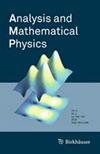Lyapunov exponent for quantum graphs coded as elements of a subshift of finite type
IF 1.6
3区 数学
Q1 MATHEMATICS
引用次数: 0
Abstract
We consider the Schrödinger operator on the quantum graph whose edges connect the points of \({{\mathbb {Z}}}\). The numbers of the edges connecting two consecutive points n and \(n+1\) are read along the orbits of a shift of finite type. We prove that the Lyapunov exponent is potitive for energies E that do not belong to a discrete subset of \([0,\infty )\). The number of points E of this subset in \([(\pi (j-1))^2, (\pi j)^2]\) is the same for all \(j\in {{\mathbb {N}}}\).
编码为有限型子移元素的量子图的Lyapunov指数
我们考虑量子图上的Schrödinger算子,其边连接的点 \({{\mathbb {Z}}}\). 连接两个连续点n和的边的个数 \(n+1\) 是沿着有限型移位的轨道读取的。我们证明了李雅普诺夫指数对于能量E是正的,当能量E不属于 \([0,\infty )\). 这个子集中点E的个数 \([(\pi (j-1))^2, (\pi j)^2]\) 对所有人都一样吗 \(j\in {{\mathbb {N}}}\).
本文章由计算机程序翻译,如有差异,请以英文原文为准。
求助全文
约1分钟内获得全文
求助全文
来源期刊

Analysis and Mathematical Physics
MATHEMATICS, APPLIED-MATHEMATICS
CiteScore
2.70
自引率
0.00%
发文量
122
期刊介绍:
Analysis and Mathematical Physics (AMP) publishes current research results as well as selected high-quality survey articles in real, complex, harmonic; and geometric analysis originating and or having applications in mathematical physics. The journal promotes dialog among specialists in these areas.
 求助内容:
求助内容: 应助结果提醒方式:
应助结果提醒方式:


